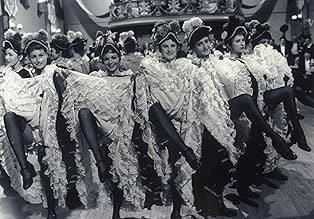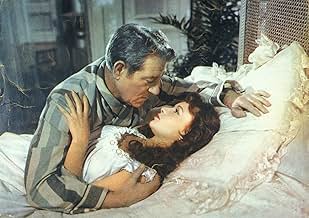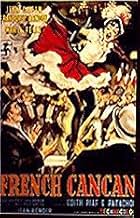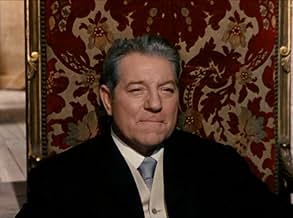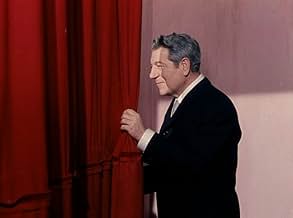IMDb रेटिंग
7.3/10
4.7 हज़ार
आपकी रेटिंग
अपनी भाषा में प्लॉट जोड़ेंThis comedy drama from Jean Renoir chronicles the revival of Paris' most notorious dance as it tells the story of a theater producer who turns a humble washerwoman into a star at the Moulin ... सभी पढ़ेंThis comedy drama from Jean Renoir chronicles the revival of Paris' most notorious dance as it tells the story of a theater producer who turns a humble washerwoman into a star at the Moulin Rouge.This comedy drama from Jean Renoir chronicles the revival of Paris' most notorious dance as it tells the story of a theater producer who turns a humble washerwoman into a star at the Moulin Rouge.
फ़ीचर्ड समीक्षाएं
Acknowledgments to Cole Porter from whose lyric CanCan (the title song of his 1953 Broadway show of the same name) I take my one line summary. This is, purely and simply, a Valentine to Paris, the Belle Epoque, the Impressionists, you-name-it. As such it is both stunning and sumptuous.Gabin - who began in the French Music Halls - is superb, but then when isn't he, Arnoul is a revelation. More? Well, the photography is ... the music is ... the ambience is ... aw, what the hell, go see it, do yourself a great big favor. 9/10
I would give this evocation of the early Moulin Rouge a high rating for the final fifteen minutes alone, a dazzling recreation of what might have been the riotous presentation of the French Cancan during the Belle Epoque, all color and noise and organized mayhem.
This is an old-fashioned film about a theatrical entrepreneur who turns working girls into stars--one at a time. Likable roué Jean Gabin plays Danglar with great aplomb, and having worked in the theatre myself, recognize the fine backstage moment in the film where the creator does not hurry to see his final creation; it is a quiet, subtle moment, and like much in the film, can be lost in the build-up to the opening of France's most famous dance hall; the color is mint Technicolor, the acting spot on, and, while old-fashioned, the film is a lovely evocation of an imagined past.
This is an old-fashioned film about a theatrical entrepreneur who turns working girls into stars--one at a time. Likable roué Jean Gabin plays Danglar with great aplomb, and having worked in the theatre myself, recognize the fine backstage moment in the film where the creator does not hurry to see his final creation; it is a quiet, subtle moment, and like much in the film, can be lost in the build-up to the opening of France's most famous dance hall; the color is mint Technicolor, the acting spot on, and, while old-fashioned, the film is a lovely evocation of an imagined past.
Of the several Jean Renoir films I have seen, this was by far the most interesting.
This film was obviously the inspiration for the Baz Luhrman film Moulin Rouge. Luhrman even appropriated one of the original songs for use in his film.
The film tells the story of the construction of the Moulin Rouge for the presentation of a revival of the CanCan. Although characterization is a bit weak and most characters are little more than stereotypes, the plot, music, action, and spectacular visuals more than make up for the shortcomings.
This is a loving tribute to the Paris of the impressionist period and is filmed beautifully in color.
Does anyone know if there is any truth to the tale?
This film was obviously the inspiration for the Baz Luhrman film Moulin Rouge. Luhrman even appropriated one of the original songs for use in his film.
The film tells the story of the construction of the Moulin Rouge for the presentation of a revival of the CanCan. Although characterization is a bit weak and most characters are little more than stereotypes, the plot, music, action, and spectacular visuals more than make up for the shortcomings.
This is a loving tribute to the Paris of the impressionist period and is filmed beautifully in color.
Does anyone know if there is any truth to the tale?
Portrait of a time. portrait of a legend. seductive for the genius of Jean Renoir. and for the inspired performances. and, sure, for the nostalgia of the viewer. an admirable Jean Gabin and a great embroidery of love stories, show world, rivalries and triumph. optimistic, romantic. and refreshing. and that does to it a special status. like refuge, splendid show, fairy tale and confession of a lost age.
The story is simple but the execution is marvelous. A Belle Epoque impresario, down on his financial luck, is going to open a new club, the Moulin Rouge, with a new dance, the French cancan. He encounters a working girl and makes her a dancer. She'll become a star. There are several crises to overcome before that happens.
The movie is Jean Renoir's tribute to show business, and he puts it on the screen with color, verve, humor, and humanity. There are wonderful performances by all the actors. The leads are Jean Gabin as Henri Danglard, the impresario; Francoise Arnoul as Nini, the girl who'll become a star; and Maria Felix as Lola de Castro, an overwhelmingly tempestuous beauty and Danglard's lover at the start. Gabin exudes confidence, worldly humor and dedication to show business. He even dances a bit. Arnoul is first rate, too. It looks like she was doing her own dances, and as an actress think of a young Leslie Caron with brains and charm.
The climax of the movie is the opening of the club, with Felix's star dance, comic songs, a whistler, a Danglar-discovered singer, all moving toward the introduction of the French cancan. The crises happen and are resolved. Then the cancan explodes. Dancing girls come bursting out from the stage, the front of the theater, through posters, down ropes from the balcony. The house swirls with the black tie and tails of the swells and the garish colors of the dancers' gowns. The cancan number lasts probably ten or fifteen minutes or so, all music and gaiety, all high kicks and splits. It's amazing when row after row of the dancers, moving toward the camera through the audience, leap up, legs extended straight forward and backward, backs arched, then land on the dance floor in full splits. I didn't know whether to shout or wince.
The last scene of the movie is outside the club, shot from the cobblestone street looking at the entrance. It's a medium shot and from the side street a happy, inebriated fellow in black tie and top hat staggers across, pauses to tip his hat at the camera, then staggers off. A completely charming ending.
This really is a marvelous movie.
The movie is Jean Renoir's tribute to show business, and he puts it on the screen with color, verve, humor, and humanity. There are wonderful performances by all the actors. The leads are Jean Gabin as Henri Danglard, the impresario; Francoise Arnoul as Nini, the girl who'll become a star; and Maria Felix as Lola de Castro, an overwhelmingly tempestuous beauty and Danglard's lover at the start. Gabin exudes confidence, worldly humor and dedication to show business. He even dances a bit. Arnoul is first rate, too. It looks like she was doing her own dances, and as an actress think of a young Leslie Caron with brains and charm.
The climax of the movie is the opening of the club, with Felix's star dance, comic songs, a whistler, a Danglar-discovered singer, all moving toward the introduction of the French cancan. The crises happen and are resolved. Then the cancan explodes. Dancing girls come bursting out from the stage, the front of the theater, through posters, down ropes from the balcony. The house swirls with the black tie and tails of the swells and the garish colors of the dancers' gowns. The cancan number lasts probably ten or fifteen minutes or so, all music and gaiety, all high kicks and splits. It's amazing when row after row of the dancers, moving toward the camera through the audience, leap up, legs extended straight forward and backward, backs arched, then land on the dance floor in full splits. I didn't know whether to shout or wince.
The last scene of the movie is outside the club, shot from the cobblestone street looking at the entrance. It's a medium shot and from the side street a happy, inebriated fellow in black tie and top hat staggers across, pauses to tip his hat at the camera, then staggers off. A completely charming ending.
This really is a marvelous movie.
क्या आपको पता है
- ट्रिवियाThe on-screen singer of "La complainte de la Butte" is not Cora Vaucaire (credited in the titles) as she was deemed not good-looking enough to appear on film, so Italian actress Anna Amendola was put in front of the camera and mimed to the song...
- भाव
Henri Danglard: Do I look like Prince Charming? Only one thing matters to me - what I create.
- इसके अलावा अन्य वर्जनOriginally released in the US in 1956 at 93 minutes; ten minutes of footage removed from the original French version were reinstated for 1985 reissue.
- कनेक्शनFeatured in Voyage à travers le cinéma français (2016)
टॉप पसंद
रेटिंग देने के लिए साइन-इन करें और वैयक्तिकृत सुझावों के लिए वॉचलिस्ट करें
- How long is French Cancan?Alexa द्वारा संचालित
विवरण
बॉक्स ऑफ़िस
- दुनिया भर में सकल
- $10,799
- चलने की अवधि1 घंटा 42 मिनट
- रंग
इस पेज में योगदान दें
किसी बदलाव का सुझाव दें या अनुपलब्ध कॉन्टेंट जोड़ें


![Bande-annonce [VO] देखें](https://m.media-amazon.com/images/M/MV5BMDIzNTViZDUtMTQ0MC00MDExLWFkNzYtNjJhMDlkN2YzMDRjXkEyXkFqcGdeQXRyYW5zY29kZS13b3JrZmxvdw@@._V1_QL75_UX500_CR0)
